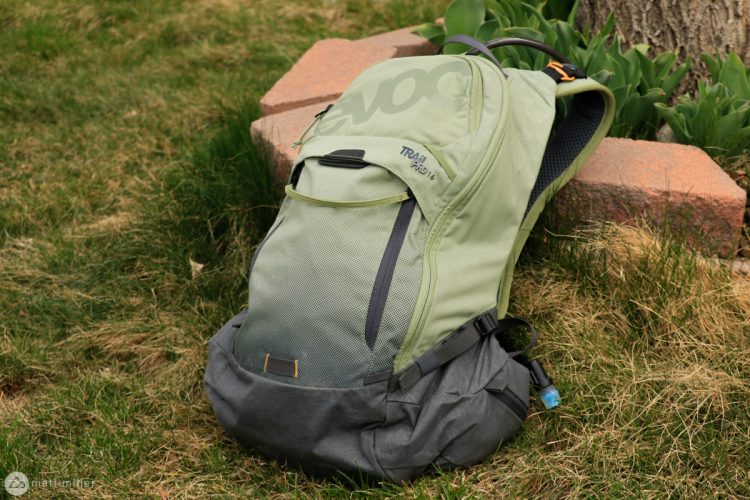

If you’re like me (and you probably are, since you’re reading this article), you love mountain biking. Inevitably, this love of mountain biking brings about a love/hate relationship with mountain bike gear. The overabundance of gear choices can be overwhelming for even an experienced mountain biker to sort through. I have found the best way to go about researching and selecting the best gear for myself is to have a laser focus on my specific needs, and in this case I needed a cycling hydration vest or small hydration pack for cross-country endurance racing.
Hydration Vest and Pack Requirements
Hydration packs come in all shapes and sizes; with or without reservoirs; and with widely varying amounts of storage. For XC racing I need a lightweight hydration vest or pack that can carry just enough water to get me through the race and just enough storage to stash my phone, keys, and maybe an energy bar and a layer of clothes (I keep my tools in a seat bag).
The catch is, I also need it to fit my slender yet curvy female form. Is that too much to ask? I was beginning to think so, because I have been frustrated in the past by packs that are either too big and heavy for racing, or ones that seem to only fit the professional cyclist body type. I recently had the opportunity to test five brands of hydration vests and packs for mountain biking that, on paper, might meet my criteria.
The cycling hydration packs I tested are priced at or under $125, and are lightweight, minimalist packs that carry either 1.5L (50oz) or 2L (70oz) reservoirs. Some are unisex and some are women’s-specific fit. They are the Camelbak Women’s Chase Bike Vest, the EVOC Hydro Pro 1.5, the USWE Outlander Pro, the Nathan Vaporairess Lite 4L Women’s vest, and the Osprey Kitsuma 1.5 Women’s pack. I was able to test these packs not only on my go-to training rides but also on a couple epic excursions. I was even able to test a few in a local XC, 40-mile endurance race series. So, how do they stack up?


Camelbak Women’s Chase Bike Vest
- Price: $100
- Available at Amazon and other retailers
Camelbak is probably the most recognized name in hydration packs, and for good reason. They have found what works and they consistently tweak what doesn’t work. This vest costs $100 retail and is sized for a women’s-specific fit (there is also a unisex version). It is listed as having 2.5L total volume with a 1.5L reservoir included, and weighs 285g empty.
Chase Vest Specs and Features
Upon first glance, the Camelbak Chase hydration vest is subdued in color and style. The “vest” material is a stretchy mesh which allows for breathability and saves bulk and weight. However, I wondered if the mesh would hold up over repeated thrashings, washing, and general wear and tear. All of the straps are adjustable with an elasticized lower chest strap, which was very comfortable against my ribcage. As with all hydration packs, it took some time to make all of the initial adjustments for fit, and it took a little while to tuck the excess away. Once I had everything adjusted and tucked in I was very happy with the fit over my chest and torso.

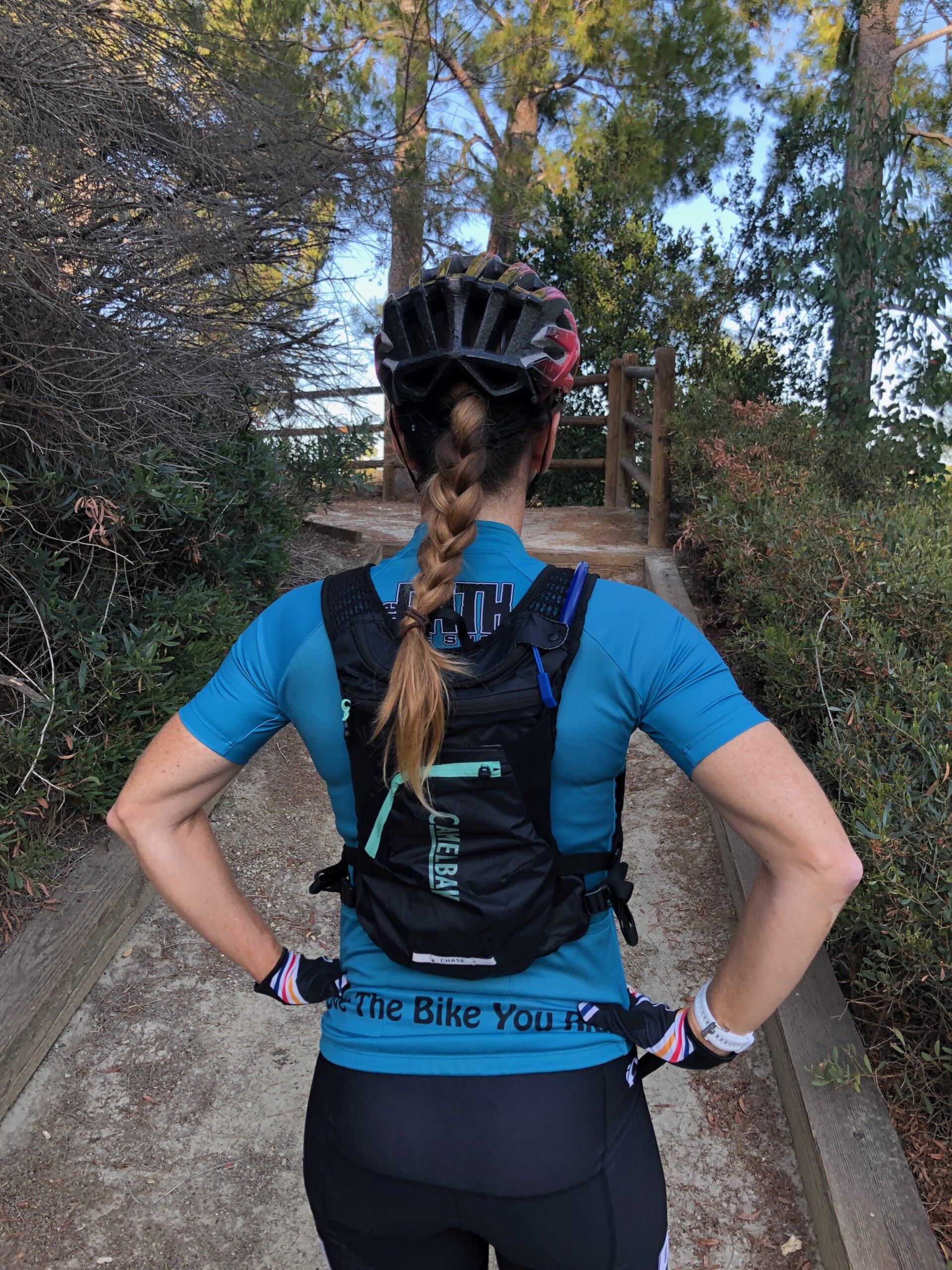
Storage consists of a fairly large zippered pocket and a small elasticized pouch on the left chest; two open, elasticized pockets on the right chest; and additional zippered and open storage in the back. For racing, I am most concerned with storage that is immediately accessible. Generally, I keep all of my nutrition in my jersey pockets or taped to my bike so I can eat on the go without having to stop. Thankfully, the fit of the hydration vest allowed for easy access to my jersey pockets so I didn’t have to make any adjustments to my race day habits.
The reservoir is a typical Camelbak design, with a super convenient handle that I loved for easy filling from a bottle or tap. My only gripe with the reservoir is that they have eliminated the old style drying hooks that clipped around the lid of the reservoir and held it open for easy drying. The reservoir straw is kept in place with two hooks, leaving the end of the straw hanging down. I worried it was going to poke me in the stomach when I was riding.
On the Trail
As I suspected, when I dialed in the fit of the Camelbak Chase bike vest, it was utterly immobile while riding a rough, twisty singletrack that normally jounces and bounces my old vest and hip packs. The only movement I noticed was the noise of the water occasionally sloshing in the reservoir, but I never felt any movement of the pack itself. That proved to be the case during my race as well, which consisted of 40 miles of desert and scrub doubletrack and singletrack.
I was a little concerned with how the straw clips into the vest and if it would require conscious thinking to clip and unclip it from both hooks during my race. It did take a little getting used to, especially clipping it back into the top and bottom holders. Once my muscle memory took over though, it got easier. Thankfully, I did not notice the end of the straw poking into my belly when riding.
The storage options worked out perfectly during casual rides, training, and racing. This was my first time wearing a vest with chest storage, and I was a little worried about carrying my phone in a chest pocket (I usually carry it in my center jersey pocket). But I ended up loving it. My phone fit snugly so it didn’t bounce around, it didn’t feel heavy, and I loved having the phone easily accessible to grab and take photos during casual rides. The only other item I packed in the chest storage was my keys (also in the zippered pocket – I don’t trust open elastic pouches), and I used the back storage for arm warmers and an extra protein bar.
Final Take Away
I was very impressed with the women’s Camelbak Chase Bike Vest. It suited my specific needs perfectly: It kept me hydrated during a race but otherwise stayed out of my way and out of my thoughts. I was happy with the comfortable mesh fit, which felt snug and secure but never restrictive. There was no awkward gapping or funny fit over my chest which I appreciated.
My main complaints about this cycling hydration vest are the difficulty drying out the reservoir between uses (Camelbak, please bring back the clips!), the slightly awkward two-hook straw clip system, and my concern about eventual wear and stretch of the mesh material.
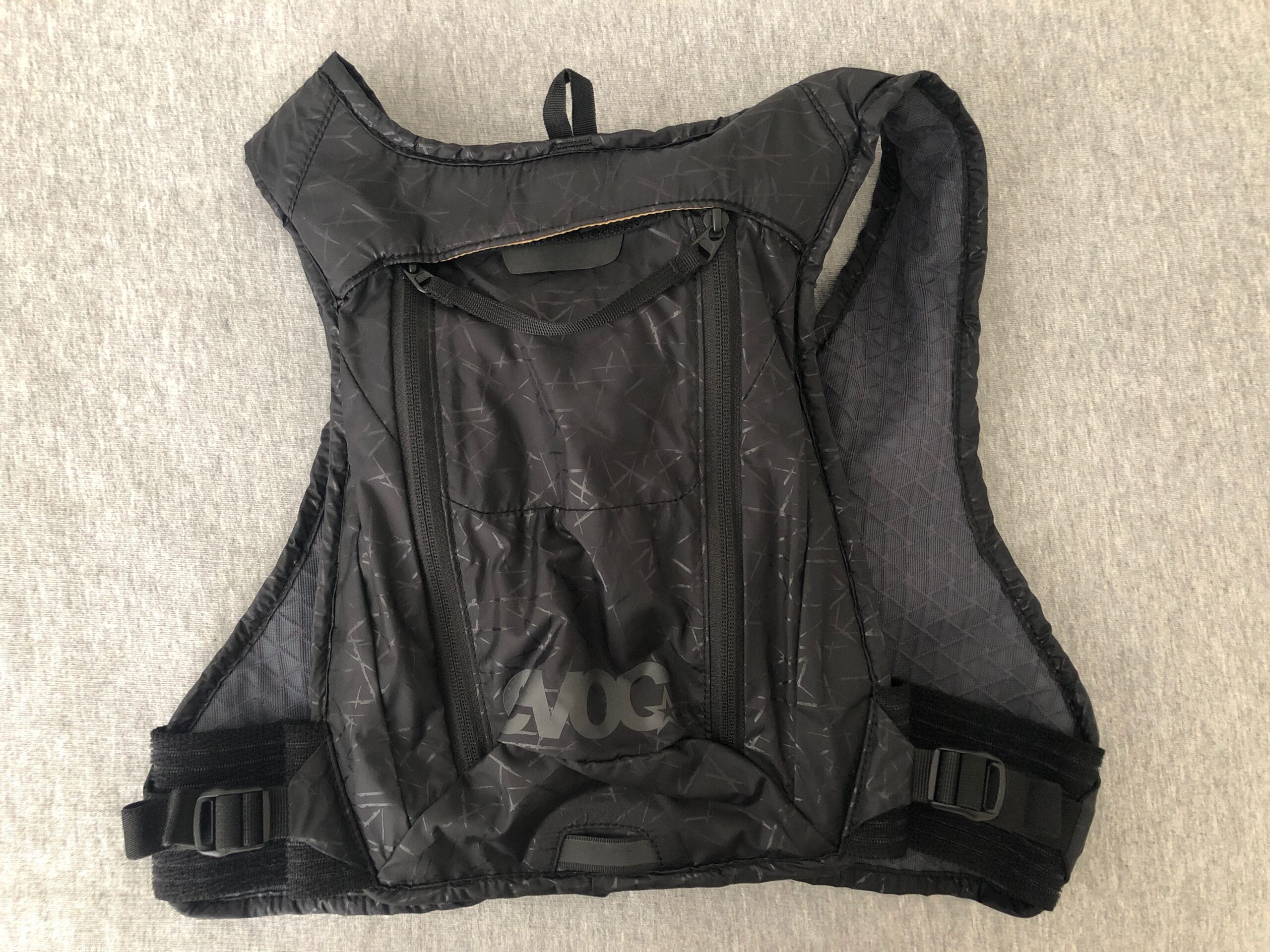
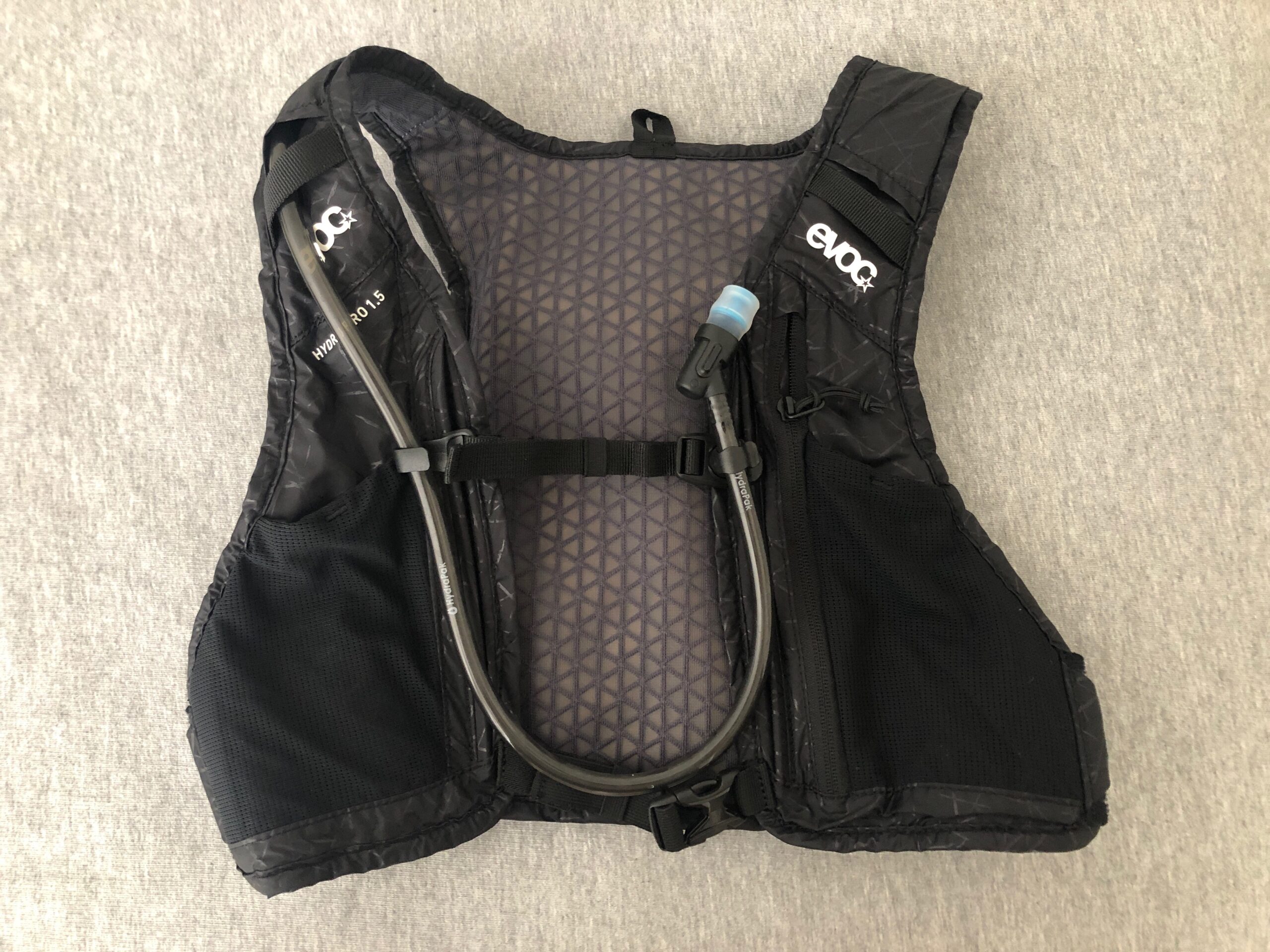
EVOC Hydro Pro 1.5 Hydration Vest
- Price: $125
- Available at EVOC Sports US and REI
The second cycling hydration vest I received was the EVOC Hydro Pro 1.5. I have never owned or tested an EVOC product, and my first impression was that it seemed similar to the subtle, understated vest design of the Camelbak. Unlike the Chase vest however, the EVOC fabric is not a mesh, but more of a traditional, lightweight tech material. The EVOC Hydro Pro has the same 1.5L reservoir but has a slightly less gear capacity of 1.5L. The EVOC Hydro Pro 1.5 hydration vest costs $125 retail and weighs 226.8g empty.
Hydro Pro 1.5 Specs and Features
When adjusting the straps for the EVOC Hydro Pro vest, I immediately noticed a few things. First, both chest straps are elasticized, and there is less excess material to deal with after adjusting. The top chest strap uses a magnet closure which also holds the straw, and it was surprisingly tricky to unhook.
Another immediate concern was the lower waist straps. These straps consist of a wide, non-adjustable elastic band beneath a smaller adjustable strap. Once I adjusted the strap there was some bunching of the wide band that I had to fold back and underneath. I was worried I would feel this when I wore the vest. The EVOC vest has a fit that feels secure and snug, with more coverage than the Chase vest while still feeling exceptionally lightweight. As with the Camelback, I was impressed with how well the EVOC hydration vest fit over my chest and torso. This was a pleasant surprise considering it’s not a women’s-specific vest.
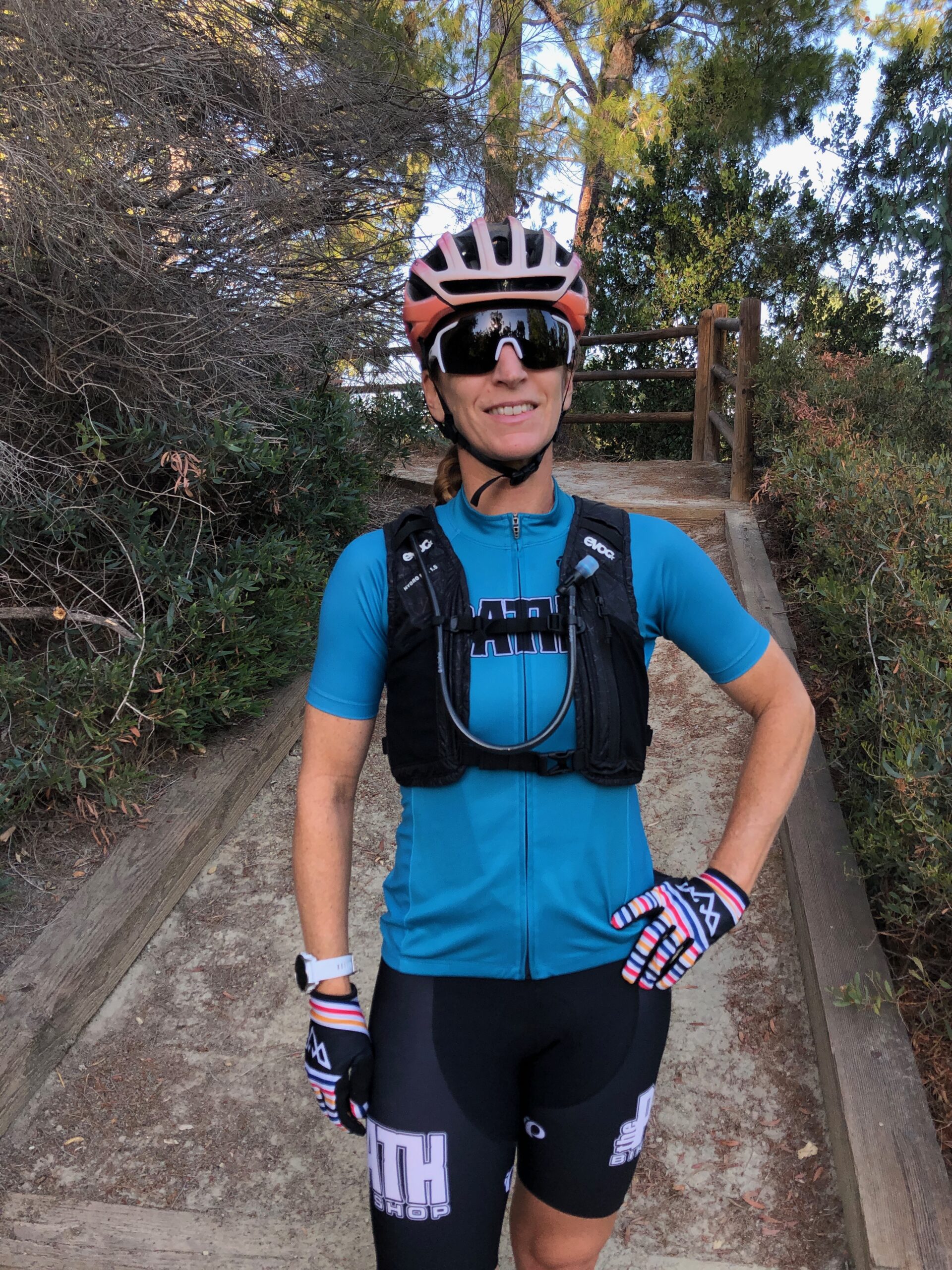

Storage on the EVOC Hydro Pro vest is very straightforward. There are two large mesh, elasticized pouches on the chest and one zippered pocket on the left chest. The back has one large zippered storage area, sharing the same access as the reservoir. The back storage opens and closes with a unique two zipper system where the zipper pulls are connected by a single handle. At first I thought this was unnecessarily gimmicky, but I ended up really loving the ease of use of this feature.
The hydration reservoir is made by Hydrapak, similar to all of the other small hydration packs tested with the exception of the Camelbak. I have to say I have never been a big fan of these reservoirs. While they are totally leakproof, I find them very hard to fill, clean and dry thoroughly. I actually had such a hard time opening this one for the first time I had to look up how to do it in a YouTube video!
On the Trail
I rode the same chunky singletrack for my first ride with the EVOC hydration vest, and I used the vest in the very next endurance race of the series at the same venue. As with the Camelbak, the EVOC Hydro Pro didn’t budge a millimeter during my rides and racing. The wide waistbands I was worried about feeling underneath the vest proved to be a non-issue, as I never noticed them. Due to the solid fabric material, the fit feels more “covered” than the Camelbak Chase, but both hydration vests practically vanished while riding.
The magnet closure of the top chest strap continued to be a bit of a bother when taking off the vest. However, even though I wasn’t in love with the magnet top closure, I did love the magnet straw attachment. It was way easier to detach and secure than the Camelbak straw, and had a satisfying “snap” feeling when securing it.
The minimalist storage features of the EVOC Hydro Pro worked out great for both casual rides and for racing. As with the Camelbak, the fit allowed for easy access to my jersey pockets for race nutrition. The zippered chest pocket is designed to securely hold a phone and keys, however, it was a little tricky to zip the pocket over my fairly small iPhone 8, which makes me wonder how hard it is to zip the pocket over larger, newer phones. The pocket itself has plenty of room and keeps small items nice and secure. The two-zipper pull system on the back storage made it super easy to access the reservoir and storage area.
Final Take Away
As with the Camelbak Chase vest, the EVOC Hydro Pro 1.5 suited my racing needs perfectly. It never moved out of place, and even though it was not made with mesh material, it felt very lightweight and breathable. The straps never dug into me or required readjusting thanks to their elastic fit. And thanks to the magnet, the drinking straw was exceptionally easy to use and put away, which is especially important during the stress of racing.
The main quibble I have with this small hydration pack is with the reservoir. Perhaps because it is so leakproof, it is hard to open wide enough to fill easily from a bottle or tap. Because of its tendency to snap shut, it is very hard to open the mouth up to clean and dry thoroughly. My second, minor complaint is with the odd magnet closure of the top strap. Despite multiple uses, I still have trouble unhooking it and would much prefer the closure that is used on every other strap on the pack.
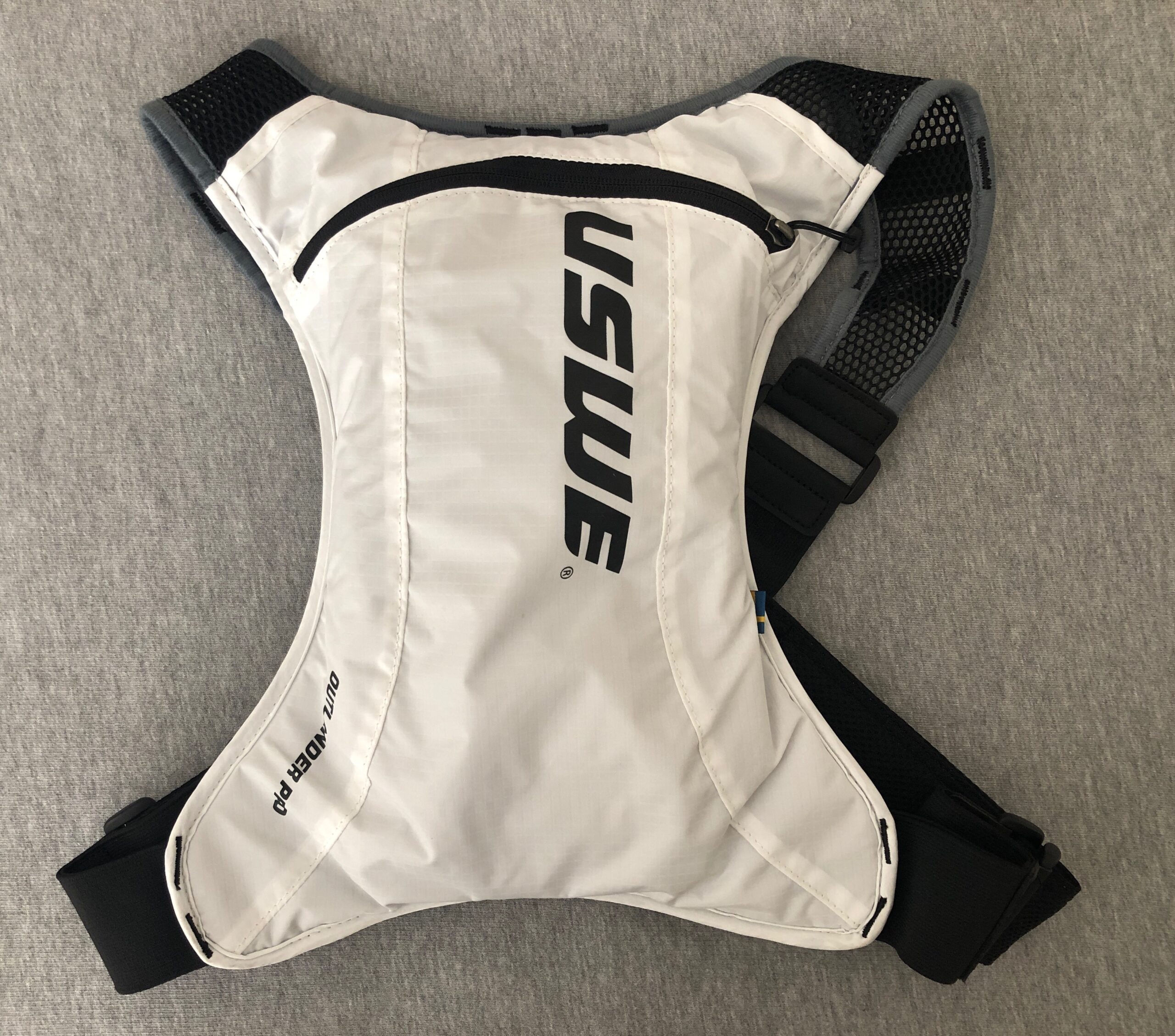

USWE Outlander Pro Hydration Pack
The USWE Outlander Pro was the hydration pack I really wanted to not like. USWE packs are very popular among professional athletes and the Instagram crowd. It looks super cool, but in the past when I’ve tried it on in the store, the criss-cross harness style of chest straps fit horribly across my chest. Nevertheless, I was happy to receive one for testing. After all, it is undeniably race-oriented, extremely lightweight, secure, and minimalist. This pack goes for $109.99 MSRP, has a 2L reservoir, and has a gear capacity of 3L. The pack weighs 260g.
Outlander Pro Specs and Features
I must emphasize that the USWE Outlander Pro hydration pack is meant for racing. The slightly larger reservoir (2L versus 1.5L) means more capacity for water during long races. However, there is NO storage on this pack, other than a small zippered pocket hidden on the inside of the reservoir storage pouch. Seriously, that’s it. For some people, that would be a deal-breaker, and USWE does make other models of packs with more storage. However, for my racing setup, this pack’s storage was perfect. The zippered pocket easily fit my phone and my keys, and if really needed, I could slide a base layer or sleeves in the reservoir pouch.


As far as the fit of the pack, I immediately noticed that the top two chest straps are non-adjustable. This worried me a bit, so I took my time adjusting what I could. I discovered there is thankfully a way to adjust the bottom straps to fit smaller torsos, and when I made that adjustment there was some excess material I had to tuck underneath. Finally, when I had everything adjusted, I noticed that although the harness did land on a weird spot on my chest, it wasn’t at all noticeable when I got on my bike. One thing I love about the harness-style straps is the one-touch, one-point clasp.
The USWE Outlander Pro’s reservoir is another Hydrapak, identical to the EVOC but with a cool red straw. Now that I know how to open one (thanks YouTube!), the Hydrapak doesn’t bother me as much as it used to, although I still prefer Camelbak’s style of reservoir. It does not have a magnetic holder for the straw, but uses a single clip similar to the Camelbak. The USWE Outlander Pro is built noticeably sturdy and tough, and gives an overall impression of quality.
On the Trail
By the time I received this pack I had finished up my racing block, so I first tested the USWE Outlander Pro on the same singletrack test loop I used for all the other mtb hydration vests. Then I took it on an epic adventure on some new trails I’d never explored before.
As I’d suspected, as soon as I got on my bike, the fit of the USWE pack settled right in and didn’t budge. It didn’t feel weird across my chest and, thankfully, the excess, tucked away material of the lower straps didn’t bother me at all. I did have to spend a little more time adjusting the lower straps but once I started pedaling everything stayed where I wanted it.
Perhaps because of the harness style configuration and wide straps, the pack didn’t feel super breathable, despite the mesh material on the top straps. However, it was comfortable enough during my excursion into the mountains on a warm day. While exploring, I ended up descending several miles of steep, loose channels that tested every ounce of my strength, ability, and mental concentration. It was during these numbing descents that I decided to like this pack. It was so secure I never even felt the water moving around my back, and because I couldn’t store a bunch of stuff in it, it stayed lightweight and invisible.
Final Take Away
The USWE Outlander Pro is unapologetically about racing, and I can appreciate that. It vanishes when riding, yet can carry enough water to get through a multi-hour ride or race. It does get the cool factor bonus points, and I fell in love with the easy single-point connection of the harness.
Off the bike, however, the awkward placement of the harness across my chest became more apparent. It is simply not a flattering or particularly comfortable style of harness for larger-chested women. I appreciated how it was a non-issue for me personally when I was riding, so I can say I’ve made my peace with the fit of the USWE. However, I think women who may be larger-chested than me might find the harness uncomfortable even on the bike.
Another takeaway I learned that applies to all of these small hydration packs is that trying it on in the store isn’t enough; it really takes some time to sort out the fit to where it’s just right on and off the bike.


Nathan VaporAiress Lite Hydration Vest
- Price: $125
- Available from REI and other retailers
Maybe I shouldn’t admit this, but I had never heard of the Nathan brand before receiving this hydration vest, so I was excited when it showed up at my doorstep. I’m always game to try new brands and see what innovations they may have. To my surprise, when I researched this vest, I found it actually caters to trail runners. However, that doesn’t necessarily mean it can’t serve multiple purposes, so I decided to put it through the wringer on the same XC trails I’ve tested the other race packs on.
The Nathan VaporAiress Lite is a women’s-specific hydration vest that comes in two sizes. This vest weighs 326g and carries a 2L reservoir. It has a 4L gear capacity with all sorts of elasticized storage pockets, but (gasp) has no zippered compartments other than a small pocket across the lower back. The Nathan VaporAiress is the most expensive hydration pack of the group at $125.
VaporAiress Specs and Features
The Nathan VaporAiress Lite vest made two huge immediate impressions on me. The first, as mentioned, was the lack of zippered or closable storage pockets. Even the reservoir isn’t stored in a closable pocket. All of the storage consists of pouches with open, elastic closures, with the exception of one zippered back pocket. As I mentioned, I don’t carry a whole lot with me when I race, but I still want my things to be secure – especially my keys and phone! Let’s just say I was a little nervous when heading out on my first ride wearing this vest.

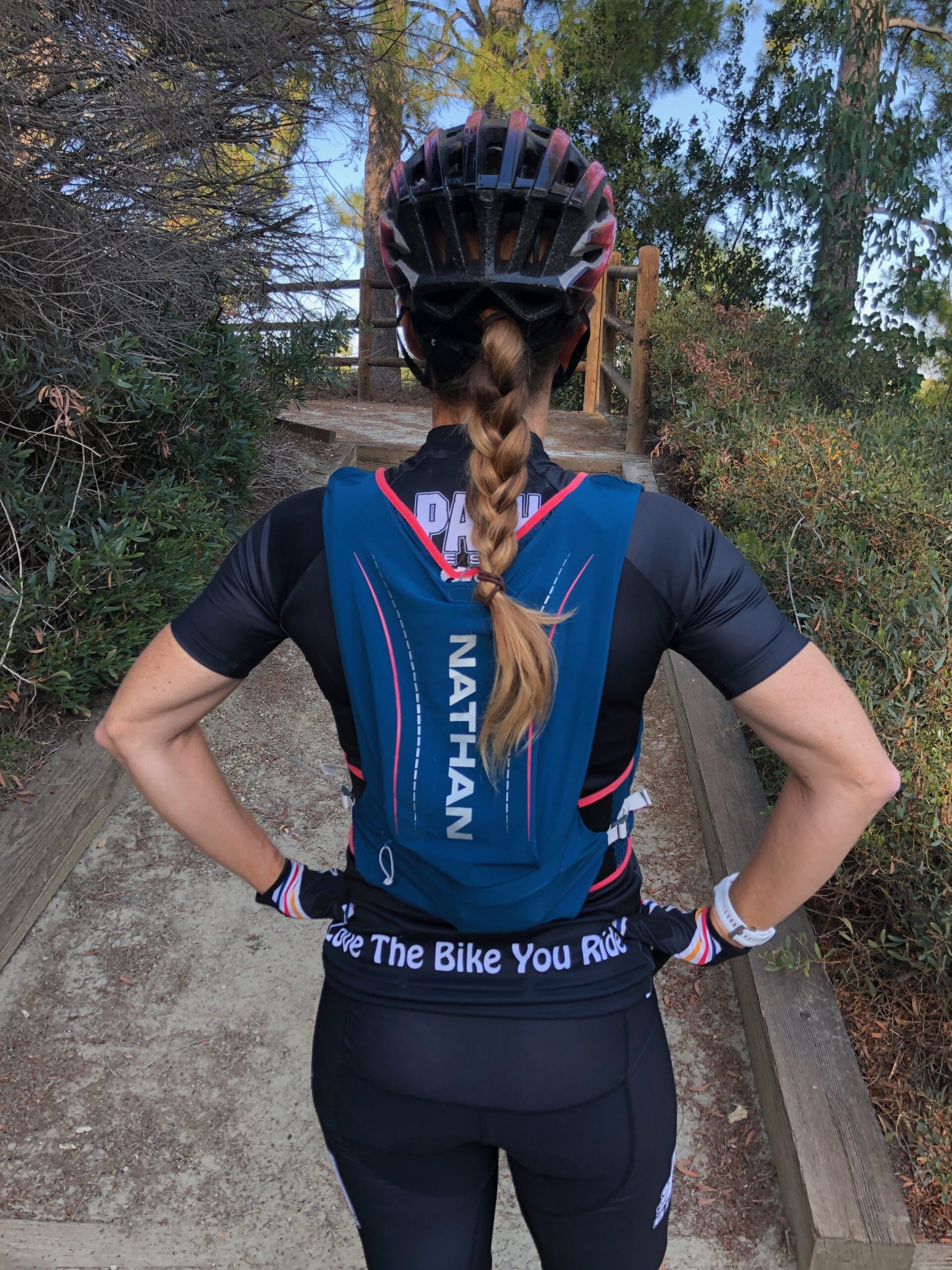
The fabric on the Nathan VaporAiress Lite also stands out. It’s soft and feels just like a t-shirt. I was intrigued and loved how comfortable it felt to wear it, but I also was a little concerned about how sweat-soaked it could possibly get.
Setting these unique factors aside, the fit of the Nathan vest was a little tricky. I quickly discovered the lower waist straps have to be tightened VERY snug to keep the reservoir secure against my back (this is where the soft, pliable fabric doesn’t help). I couldn’t adjust the lower straps while wearing the vest, so each time I wanted to make a change I had to take the vest off to do it. However, I loved the overall adjustability of the lower waist/lumbar straps. The top chest strap, not so much. Even though the top strap can slide up and down on the shoulder straps, I was unable to move it high enough to where I wanted it, so it ended up resting in a very weird spot across my chest.
On the Trail
Once I got on my bike in preparation for my first ride wearing the Nathan vest, I breathed a sigh of relief: my phone, which I was the most worried about carrying in an elastic pocket, ended up living quite happily in the left-side chest compartment. It turns out the chest compartment pockets are pretty deep and held my phone securely on the rough and rocky trails. My keys also ended up nice and secure in the zippered back pocket. So, the lack of zippers and secure closures ended up being a non-issue.
The t-shirt material felt as I suspected it would: supremely soft and comfortable. However, as I also suspected, by the end of a one hour ride, the back of the hydration vest was soaked with sweat. So much so that I had to basically dump it straight in the bathtub when I got home from my rides.
Final Take Away
The Nathan VaporAiress Lite performed very well as a small hydration pack for mountain biking, which was surprising considering it’s really meant more for trail running. The soft material did end up being on the sweaty side, and it was not quite supportive enough to keep the full reservoir from sloshing and moving a bit on my back during rough descents. The open pockets ended up working just fine for riding. After riding the trails I rode with this vest, I doubt anything would fall out of the deep chest pockets, except maybe during an over-the-bars, hard crash!
I think this Nathan hydration vest would work just fine for those people who do both trail running and mountain bike racing and who don’t want to spend extra money on two hydration packs. However, it does undeniably have some drawbacks for mountain biking compared to the purpose-built packs in this group.

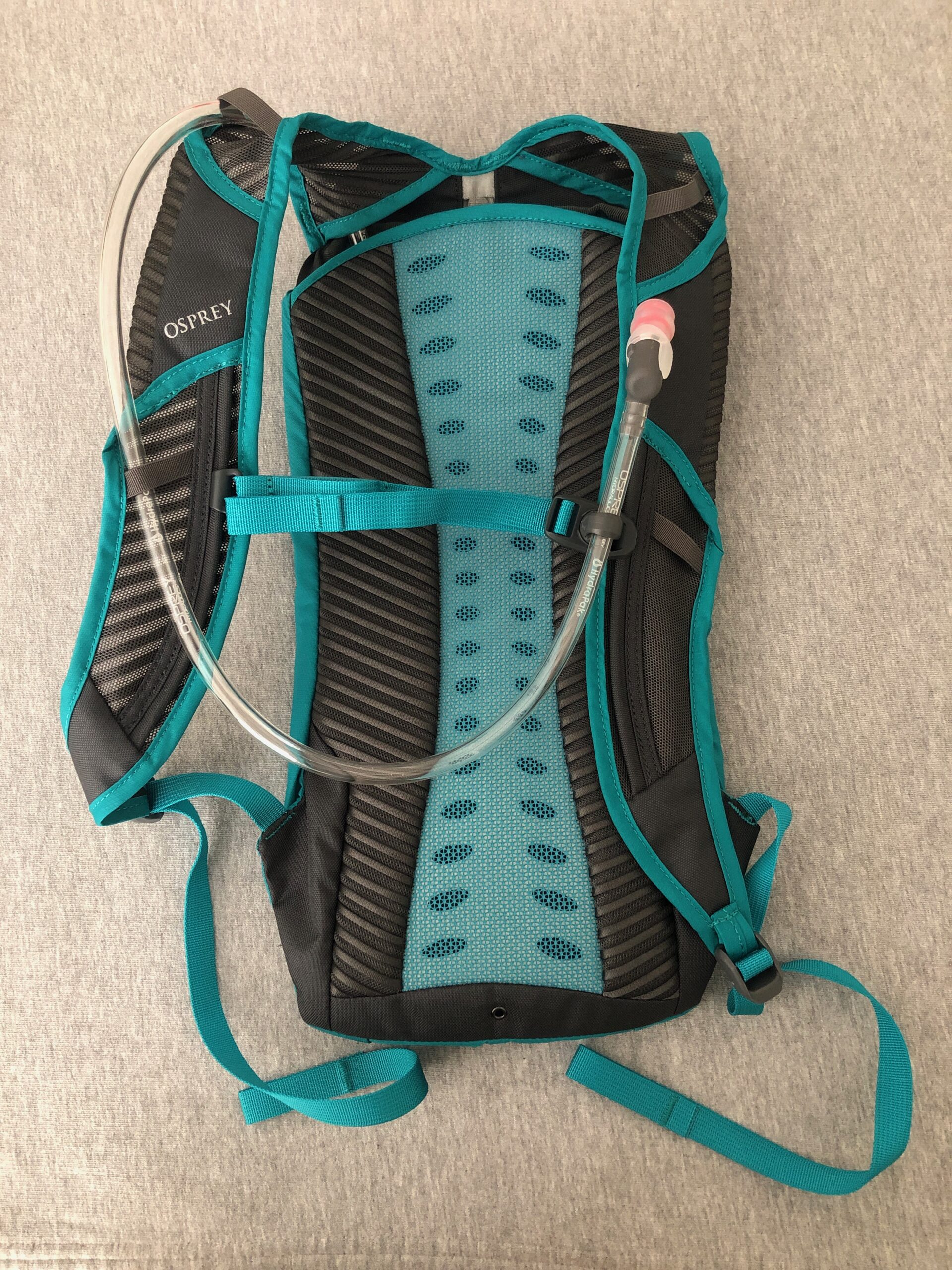
Osprey Kitsuma 1.5 Hydration Pack
- Price: $65
- Available from Osprey and other retailers
I’ve heard great reviews about Osprey packs, but never had the opportunity to try one out, so I was really excited to receive the Osprey Kitsuma 1.5 women’s hydration pack to test. The small hydration pack claims to be the lightest in this group at 210g. It holds a 1.5L Hydrapak style reservoir and has 1.5L total volume. It retails for $65 making it the most economical choice of the bunch.
The Osprey Kitsuma 1.5 has the most traditional, “hydration pack” look to it. There is mesh fabric incorporated into the pack, however the look and feel is much more structured than the other packs with the exception of the USWE. On closer inspection, however, you notice just how minimalist it is compared to traditional packs. There is no storage on the pack except for a medium-sized zippered pocket along the top of the back of the pack, unless you count the pocket the reservoir lives in as storage.
Kitsuma 1.5 Specs and Features
My first impression was an immediate concern as soon as I lifted it out of the box. There is only one chest strap on the pack. I actually had to turn it around and inspect everything to make sure I was getting that fact right. The single chest strap can slide up and down on the shoulder straps, and has some elastic in it, but that was it. The only other adjustable features are the bottoms of the shoulder straps, which can be easily tightened by pulling on them, similar to school backpacks. I was not sure how the hydration pack was going to fit and if it was going to be secure.


Another odd aspect of the Osprey Kitsuma is the Hydrapak reservoir. Just when I thought I was getting used to all of these packs with their Hydrapak reservoirs, the Osprey threw me for a loop. This was something else I actually had to go online and confirm, but the reservoir straw has no quick disconnector.
This means in order to take out and replace the reservoir, you have to thread the straw all the way through the straps. To make the process easier it is possible to remove the mouthpiece, however, that leads to potential spillage if there is water in the reservoir. This “feature” makes absolutely no sense to me, and is oddly specific to only the Osprey Kitsuma 1.5L reservoir.
On the Trail
As I had feared, my concern about the fit of the Osprey Kitsuma was well-founded. When I tried on the vest, I couldn’t find a comfortable placement for the sliding chest strap. Too high, and the shoulder straps cut into my neck. Too low, the shoulder straps gaped awkwardly. I ended up with the chest strap in a weird place on my chest but it was the only way I could be comfortable with the shoulder straps.
I like how easy it is to pull and adjust the shoulder straps, and pulling them tight does result in a nice and secure fit of the hydration pack. However, I ended up with literally over a foot of excess strap material hanging down my back in my test. I was surprised that Osprey doesn’t offer a way to fold and secure this excess material, and this ended up being the single most annoying thing during my rides.
While wearing the Osprey Kitsuma hydration pack on my singletrack test loop, I was impressed with how lightweight it is, and that it didn’t budge during my descents. I loved the magnetic clip securing the straw to the chest strap, which really should be mandatory on every hydration pack.
The storage also worked out fine for my needs. I simply put my phone and keys in the zippered pocket and kept my nutrition in my jersey pockets as I normally do for racing. I didn’t need extra layers of clothing during my test rides, but if I did need storage for them I could stuff them in the reservoir pocket.
Final Take Away
I really wanted to love the Osprey Kitsuma 1.5 hydration pack. After all, Osprey is known for its quality design and cool features. They were one of the first, if not the first, to use the magnetic clip for the straw, which I love.
However, I just couldn’t get over the two flaws in this pack. The excess shoulder strap material was so long and loose it slapped against my body while I was riding. This was the only pack that I even consciously thought about during my rides – it was that much of a distraction. Of course I could cut the excess material, but it’s annoying to me to have to do that simply because Osprey didn’t put a simple band in place to hold the excess.
The other flaw with the Osprey Kitsuma is the reservoir. It was frustrating to have to deal with threading the straw through multiple openings just to remove and install the reservoir, especially when I know just how easy it is to have a quick-disconnect. I don’t know if they’ve done this to save costs or prevent leaks, but to me I’d rather spend the extra money or suffer the occasional leak (which hasn’t happened yet on any of my other Hydrapaks) and have the convenience of a disconnecting hose.
The Wrap Up
After a whirlwind past few months of rides, races, adjustments, tweaks, and water filling and emptying, I have to say that I’m impressed with how far small hydration packs have come for mountain bikers. All of these five hydration vests and packs were utterly immobile on my back during all sorts of riding conditions, from one-hour training rides, to 40 miles of racing, to hike-a-biking.
Finding the Proper Fit
The key with all of the hydration vests and packs was taking the time to adjust all of the straps to my liking. I noticed with a few packs, in particular the Osprey, the Nathan and USWE, that while I may not have liked how the upper straps fit across my chest, once I was actually on the bike the fit became very comfortable. Now if I were hiking, the fit across the chest might have been more of an issue, but for mountain biking they were all very comfortable.
I was surprised at how the hardest packs to fit properly on me were two of the women’s-specific hydration packs from Nathan and Osprey. And, even though I was pleasantly surprised that the USWE pack fit me as well as it did, I can’t imagine larger-chested women would love the fit of this pack.
Storage is Critical
Even though I was looking for hydration vests and packs that were race-ready with minimal storage, I did end up being a little concerned with the storage options on a few of these packs. The Osprey and USWE packs have no storage except for a small, phone-sized zippered pocket. The Nathan has plenty of storage but most of it isn’t very secure. In warm weather, packs like these are perfect for racing and quick rides, where all you want is some water, nutrition, your keys and your phone. However, during cold weather rides, I would have to be a little more thoughtful about what layers to bring and how to store them in the pack. Luckily, no matter how minimalist a small hydration pack may be, there is always the option to store clothing in the reservoir pocket.
Here are a few of my final takeaways regarding these hydration packs.
All winners
All of the hydration vests and packs felt very secure riding over a wide variety of terrain. While racing or riding, I simply didn’t think about them very much, which is exactly what you want in a hydration pack.
All losers
My one wish for hydration vests and packs is for someone to come up with a nifty way to dry reservoirs. I definitely preferred the Camelbak reservoir for ease of use and filling, however none were particularly easy to dry, and I usually end up either propping them up upside-down over a jar or stuffing some clean rags into them.
Best fitting cycling hydration vests and pack (for me)
Camelbak Chase, EVOC HydroPro 1.5, and USWE Outlander.
Worst fitting cycling hydration vest and pack (for me)
Osprey Kitsuma and Nathan Vaporairess Lite.
Best cycling hydration vest and pack for racing
For racing it would be hard to beat the EVOC Hydro Pro 1.5, the Camelbak Chase and the USWE Outlander Pro. In super hot conditions, I would lean toward the Camelbak simply because the mesh fabric is so light and breathable. For endurance racing or cold conditions, I would lean toward the Camelbak or the EVOC because they offer slightly more storage in chest compartments and back pockets. And for gnarly, technical races I would pick the USWE because it is built like a tank but is somehow still extremely lightweight.
Worst cycling hydration vest for racing
Although the Nathan Vaporairess Lite ended up working out fine for storing my phone and keys, I would still be a little nervous about where my valuables would end up if I were to have an over-the-bars style crash. I’m also pretty sure if I raced an endurance race in warm conditions wearing this vest, I would have a sodden, sweaty, fabric mess to deal with by the end.
Other cycling hydration vests to consider (not tested)
- Ultimate Direction Trail Vest ($99.95)













